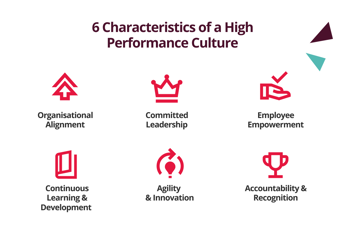 PeopleXD
PeopleXD
How to Build and Sustain a High Performance Culture in Large Organisations
Organisations with high performance cultures consistently outperform their peers through improved productivity, enhanced innovation, stronger employee retention, and increased profitability. However, large organisations face unique challenges in building and sustaining such cultures, from maintaining consistency across diverse teams to ensuring cultural values remain embedded during periods of rapid growth or change.
This comprehensive guide explores the essential characteristics that define a high performing culture, examines the tangible benefits organisations can expect, and provides actionable strategies for building a high-performance culture at scale.

In this article we will explore the following areas:
- What is a high-performance culture?
- 6 characteristics of a high-performance culture
- What are the benefits of a high performance culture
- What are the steps in building a high performance culture?
- How can you then sustain that culture?
- Creating a culture that performs and lasts
- Ready to build a high-performance culture in your organisation?
What is a high-performance culture?
A high-performance culture is an organisational environment that empowers employees to do their best work by aligning individual purpose with strategic goals whilst fostering accountability, innovation, and continuous growth. Unlike traditional cultures that rely on rigid hierarchies and micromanagement, high-performing cultures prioritise trust, autonomy, and shared ownership of outcomes.
At its core, this type of culture creates an environment where employees feel psychologically safe to take calculated risks, speak up with ideas, and learn from failures. It emphasises purpose over process, results over activity, and growth over perfection. Employees understand not just what they need to do, but why their work matters to the broader organisational mission.
The foundation rests on three critical elements:
- Psychological safety that encourages open communication and risk-taking
- Autonomy that gives employees ownership over their work and decisions
- Purpose that connects individual contributions to meaningful organisational outcomes.
When these elements work together, they create a self-reinforcing cycle of engagement, performance, and growth.
“In a knowledge economy, your only sustainable competitive advantage is the capability of your people.”
6 characteristics of a high-performance culture
1. Organisational Alignment
High-performing organisations create crystal-clear connections between individual roles and organisational strategy. Every employee understands how their daily work contributes to broader business objectives. This alignment extends beyond job descriptions to encompass shared values, common language, and unified metrics that everyone understands and works towards.
Successful alignment requires regular communication of strategic priorities, transparent goal-setting processes, and consistent messaging from leadership. When done effectively, it creates a sense of shared purpose that motivates employees and ensures everyone is pulling in the same direction.
2. Committed Leadership
Leadership commitment goes far beyond verbal support—it requires leaders to actively model the behaviours they expect, serve as mentors and coaches rather than just managers, and champion cultural values even when faced with difficult decisions. These leaders understand that culture is built through consistent actions, not corporate communications.
Committed leaders invest time in developing their people, provide regular feedback and recognition, and create opportunities for others to grow and succeed. They demonstrate vulnerability by admitting mistakes and showing how failure can lead to learning and improvement.
3. Employee Empowerment
Empowerment means giving employees the authority to make decisions within their scope of responsibility, access to the information and resources they need to succeed, and trust to take ownership of their outcomes. This goes beyond delegation - it's about creating an environment where people feel confident to act without constant approval-seeking.
Empowered employees are more engaged, innovative, and resilient. They take initiative, solve problems proactively, and feel a stronger connection to their work because they have genuine influence over how it gets done.
4. Continuous Learning & Development
High-performance cultures prioritise ongoing development through coaching, regular feedback, skill-building opportunities, and knowledge sharing. This isn't limited to formal training programmes - it encompasses everyday learning through challenging assignments, cross-functional collaboration, and mentorship relationships.
Organisations can leverage digital learning platforms to make development more accessible and scalable across large teams. These tools enable personalised learning paths, microlearning opportunities, and just-in-time skill development that supports both individual growth and organisational performance.
5. Agility & Innovation
These cultures embrace rapid learning cycles, encourage calculated experimentation, and maintain adaptability in the face of change. They create safe-to-fail environments where teams can test new ideas quickly, learn from results, and iterate based on feedback.
Agile cultures balance stability with flexibility - they maintain core values and purposes whilst remaining open to new ways of working, evolving customer needs, and market changes. This requires systems and processes that support quick decision-making and implementation.
6. Accountability & Recognition
Transparent performance metrics, clear expectations, and consistent recognition systems create a culture where high performance is both expected and celebrated. Accountability isn't about blame—it's about taking ownership of commitments and learning from outcomes.
Effective recognition goes beyond annual reviews to include regular acknowledgement of contributions, both individual and team achievements, and connection of success to organisational values. Employee engagement and benefits programmes can reinforce performance by providing meaningful rewards that align with what employees truly value.

Expert Insight
Emma Parkin, Head of Propositions at The Access Group, explains how thoughtful benefits design can meet employee expectations and drive engagement.
What are the benefits of a high performance culture?
Organisations with high-performance cultures experience measurable improvements across multiple areas that drive both employee satisfaction and business results.
Higher Productivity and Engagement
Higher productivity emerges naturally when employees are engaged, empowered, and aligned with clear objectives. These organisations typically see 20-30% improvements in productivity metrics compared to their peers (TeamStage Employee Engagement Statistics).
Enhanced Innovation and Creativity
Enhanced innovation and creativity flourish when people feel safe to experiment and share ideas. Teams generate solutions collaboratively, adapt more quickly to market changes, and create competitive advantages through more unique approaches to challenges.
Lower Employee Turnover and Improved Retention
Lower employee turnover results from increased engagement and development opportunities. When people feel valued, challenged, and connected to purpose, they're significantly more likely to stay. This reduces recruitment costs, preserves institutional knowledge, and maintains team cohesion.
Improved Financial Performance
Research from Bain & Company's High Performance Culture Study shows that organisations with strong cultures typically achieve 15-20% better financial performance than competitors, with improved profitability and revenue growth following naturally from increased productivity, innovation, and retention.
“Gallup's research is definitive: companies with engaged employees are 21% more profitable. These aren't soft benefits — they're hard financial returns that any CFO would pursue aggressively.”
Emma Parkin, Head of Propositions, The Access Group from our webinar ‘Beyond Annual Reviews From Skills Gaps to Business Impact’
Stronger Brand and Talent Attraction
According to research, stronger brand reputation and talent attraction create virtuous cycles where top performers seek out these organisations, further strengthening cultural excellence (Heidrick & Struggles' Culture and Financial Performance). Companies known for high-performance cultures become employers of choice in their markets.
PeopleXD Evo customer PKF Francis Clark exemplifies these benefits, demonstrating how their strong internal culture—rooted in care, inclusion, and value—creates an environment where colleagues are empowered and supported. Their cultural transformation initiatives, supported by integrated HR technology, have delivered measurable improvements including increased efficiency through process automation, time savings that allow consultants to focus on higher-value activities, and enhanced productivity across their 500+ employee organisation.
What are the steps in building a high performance culture?
Building culture starts with clarity about why the organisation exists and what principles guide decision-making. This requires aligning individual purpose with organisational mission, ensuring everyone understands how their work creates value for customers and society.
As Kieran Glackin, HR Director at Madano, notes in Episode 8 of "Do the Best Work of Your Life" Supercharge Talent and Drive Performance:
"There are probably three principles that are really easy to follow: clarity, communication and accountability. If those three things are followed, regardless of role or sector, you'll get the best engagement from an employee."
Successful purpose definition involves employees in the process, connects to meaningful outcomes beyond profit, and provides a framework for making difficult decisions when values and short-term pressures conflict.
Build the Right Teams
High-performance cultures require teams that are cross-functional, empowered to make decisions, and accountable for outcomes. This means moving beyond traditional silos to create groups that can deliver end-to-end value.
Building the right teams involves careful attention to both technical skills and cultural fit, clear role definitions that avoid gaps and overlaps, and team dynamics that encourage collaboration and healthy conflict resolution.
Create Proof of Success
Rather than attempting organisation-wide transformation immediately, successful culture building starts with pilot initiatives that demonstrate value and create models for scaling. These proof points build credibility and provide learning opportunities before broader implementation.
Effective pilots are carefully designed experiments with clear success metrics, sufficient resources to succeed, and strong leadership support. They create templates that can be adapted and scaled across different parts of the organisation.
Encourage Feedback and Transparency
Honest conversations and data-driven reviews create the foundation for continuous improvement. This requires systems that encourage open communication, regular check-ins between managers and team members, and transparent sharing of performance data and organisational challenges.
Feedback culture extends beyond formal reviews to include real-time coaching, peer feedback, and upward feedback that helps leaders understand their impact on the organisation.
Invest in Leadership Development
Leaders at every level need skills in coaching, mentoring, and inspiring others. This goes beyond traditional management training to include emotional intelligence, change leadership, and culture-building capabilities.
A fully unified HR software suite connects performance management, succession planning, skills assessment tools, learning and employee benefits and engagement.

How can you then sustain that culture?
Monitor and Measure Culture Health
Sustaining culture requires ongoing assessment through employee surveys, performance metrics, and regular pulse checks. Organisations need both quantitative data on engagement and productivity, and qualitative insights about employee experience and cultural alignment.
How can leaders tell if their cultural initiatives are actually working?
The key lies in looking beyond traditional satisfaction surveys to measure behavioural indicators. Are employees taking initiative without being asked? Are they collaborating across departments naturally? Are they staying longer and performing better? These observable behaviours often provide more reliable insights than survey responses alone.
Technology enables more sophisticated culture measurement, providing real-time insights that help leaders make informed decisions about cultural health and necessary interventions.
Adapt to Change
Cultures must evolve to remain relevant and effective. This is particularly important as organisations navigate hybrid work environments, generational differences, and changing business conditions. Successful adaptation maintains core values whilst adjusting practices and processes.
This requires ongoing dialogue about what's working and what needs to change, experimentation with new approaches, and willingness to abandon practices that no longer serve the organisation's needs.
Reinforce Through Rituals and Communication
Regular check-ins, storytelling that highlights cultural values in action, and consistent recognition help embed culture in daily operations. These touchpoints remind everyone why culture matters and how it shows up in real situations.
Effective reinforcement includes celebrating both successes and learning from failures, sharing stories that illustrate values in action, and creating rituals that bring people together around shared purposes.
Avoid Common Pitfalls
Common mistakes include overemphasising underperformers at the expense of developing high performers, providing insufficient feedback for continuous improvement, and allowing cultural practices to become stagnant rather than evolving with organisational needs.
Successful culture sustainability requires balancing attention to all performance levels, maintaining fresh approaches to cultural reinforcement, and regularly reassessing whether cultural practices still serve their intended purposes.
Creating a culture that performs and lasts
Building and sustaining a high-performance culture in large organisations requires intentional, consistent effort from leadership at every level. It's not a one-time initiative but an ongoing commitment to creating environments where people can do their best work whilst contributing to meaningful organisational outcomes.
Remember that high performance isn't just about productivity - it encompasses employee wellbeing, engagement, and growth. The most successful cultures recognise that sustainable performance comes from supporting the whole person, not just driving output.
Leaders must take a proactive role in shaping and sustaining culture, understanding that their actions and decisions have far-reaching impact on organisational health. Technology can serve as a powerful enabler of cultural transformation, providing tools for communication, measurement, development, and recognition that support cultural excellence at scale.
The investment in building a high-performance culture pays dividends not just in immediate business results, but in creating organisations that can adapt, innovate, and thrive regardless of external challenges.
Ready to build a high-performance culture in your organisation?
Building and sustaining a high performance culture requires more than good intentions—it demands the right tools, systems, and ongoing measurement to drive real behavioural change. Access Group's integrated HR solutions provide the technological foundation to support every aspect of cultural transformation at scale.
Align Your People with Purpose-Driven Technology
Our PeopleXD Evo HR suite puts people at the heart of your business with AI-enabled HR software designed for organisations over 500 employees. By automating up to 60% of administrative tasks, your HR teams can focus on higher-value activities like coaching, development, and culture building. The platform's powerful analytics provide real-time insights into engagement patterns, performance trends, and cultural health metrics - giving you the data you need to make informed decisions about your cultural initiatives.
Measure and Sustain Cultural Excellence
Our HR software includes integrated talent management including configurable performance management systems that drive continuous improvement and goal alignment. With real-time appraisal updates and detailed reporting, you can track how well your cultural values are being embedded across the organisation and identify areas for development before they become performance issues.
Empower Through Recognition and Engagement
High performance cultures thrive on recognition and meaningful engagement. Our Access Engage platform addresses the reality that only a fraction of employees feel truly engaged at work through comprehensive reward and recognition software, peer-to-peer recognition systems, and customisable employee benefits platforms. These tools help create the psychological safety and sense of value that are fundamental to high-performing cultures.
Proven Impact at Scale
Organisations using our solutions report measurable improvements that align directly with high performance culture benefits: cost savings through automation, significant reductions in administrative burden, and dramatic time savings (tasks that previously took six hours now completed in under 60 minutes). More importantly, they're building cultures where employees feel empowered, supported, and aligned with organisational purpose.
Ready to transform your HR experience?

HR software brochure
Find out how our HR software can help you achieve your business goals.

Schedule your demo
One of our HR software experts will be in touch to build a demo with the features you need to see.

Watch 4-min demo
Explore the features and benefits PeopleXD Evo offers in our 4 minute video.

Unlock Expert HR Insights
Stay ahead in the ever-changing world of HR with our on-demand webinar hub. Explore a wide range of sessions led by industry experts.

 AU & NZ
AU & NZ
 SG
SG
 MY
MY
 US
US
 IE
IE
